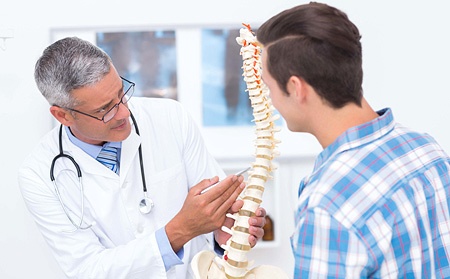 100 million Americans live with chronic pain. That is more than diabetes, heart disease and cancer combined. Of those, over 26 million Americans between the age of 20 and 64 suffer from lower back pain.
100 million Americans live with chronic pain. That is more than diabetes, heart disease and cancer combined. Of those, over 26 million Americans between the age of 20 and 64 suffer from lower back pain.
Chronic lower back pain management treatments can generally be divided into two categories- surgical and non-surgical. Some non-surgical treatments include:
- physical therapy
- pharmacological treatments like anti-inflammatories
- opiate medications and muscle relaxants
- neuraxial steroidal injections
In terms of treatment, spinal decompression and spinal fusions are situated at the opposite end of the spectrum. This gives way to a unique and prevalent third category comprised of people whose conditions necessitate a treatment more intensive than the non-surgical options mentioned above, but less drastic than spinal decompression and fusion.
This middle category is referred to as intermediate chronic lower back pain. What is unique is that for over 40 years, one treatment was the prevailing therapy for the entire category. That therapy is traditional (Regular frequency) spinal cord stimulation (SCS). It caters to patients as a niche treatment and is a very effective, drug-free, minimally invasive, and reversible option.
Traditional SCS is an attractive option to patients with contraindications for surgery, those who were operated without relief or worsened pain, and for those whose conditions don’t demand more invasive surgical treatments due to lack of progressive spinal instability or neurological deficits.
The first successful implantation of a spinal cord stimulation (SCS) system was done in 1967. Since the approval of spinal cord stimulation by the U.S. Food and Drug Administration in 1989, the landscape of treatment for intermediate chronic back pain has been nearly static.
Traditional SCS delivers electrical pulses with frequencies between 2 to 1200Hz through spinal electrode leads. This type of Spinal cord stimulation (SCS) has been the treatment of choice for decades; it requires production of pleasant sensations covering the areas of pain to provide relief. This creates a predictable, localized sensation of comfort intended to mask and modulate the more intolerable chronic pain. These sensations are termed “Parasthesiae” which is colloquially described as a “tingling” or “prickling” feeling.
However, some patients may experience uncomfortable burning or shocking sensations in the areas of stimulation. Despite decades of attempts to improve the stability and adequacy of paresthesia coverage, the complex nature of lower back pain made it difficult to achieve in some cases.
In 2015, HF10™ therapy (high frequency SCS), was introduced. HF10 differs from SCS because its pulses last a short period of time and has frequencies of 10 kHz — nearly 10 times higher than that of traditional SCS. It distinguishes itself from traditional SCS in various ways:
- Patients don’t require to be awakened during implantation to help physicians find the best electrode placement
- Like in traditional SCS, patients have the option to use the system for a trial period before opting for a permanent implant
- The implant procedure is quick and minimally invasive, so typically does not require a hospital stay
- HF10™ therapy can be switched OFF and ON with the remote control at any time. Most notably, this therapy does not produce paresthesia so, unlike traditional SCS, HF10™ therapy may stay ON while you are driving or sleeping
In the greater context of intermediate chronic lower back pain treatment, Nevro is a holy grail. It has reshaped how we conceptualize treatment of chronic lower back pain. Initiatives have shifted from creating more tolerable and effective paresthesia coverage to implementing a new high frequency treatment that is paresthesia-free.
Shortly after its initial 2015 reception, The Journal of the American Society of Anesthesiologists published a study comparing the efficacy of 10-kHZ high frequency vs. traditional low frequency SCS in the treatment of both lower back and leg pain. At the 2-year mark after the procedure, 66.9% of patients that received the high frequency therapy experienced additional decrease in pain, compared to only 31.8% of patients that received traditional low-frequency SCS.
Another study indicated that back pain was reduced by more than half in 85% of the participants with HF10™ therapy, compared to 44% with low frequency therapy.
The effectiveness of SCS has been proven over decades, and Nevro’s addition to the treatments for intermediate back pain only improves the physician’s ability to optimize chronic pain treatment.
If you are tired of living with chronic back pain and want more information on Nevro or other options for minimizing or eliminating your suffering, click the button below to set up a consultation at one of our clinics.

